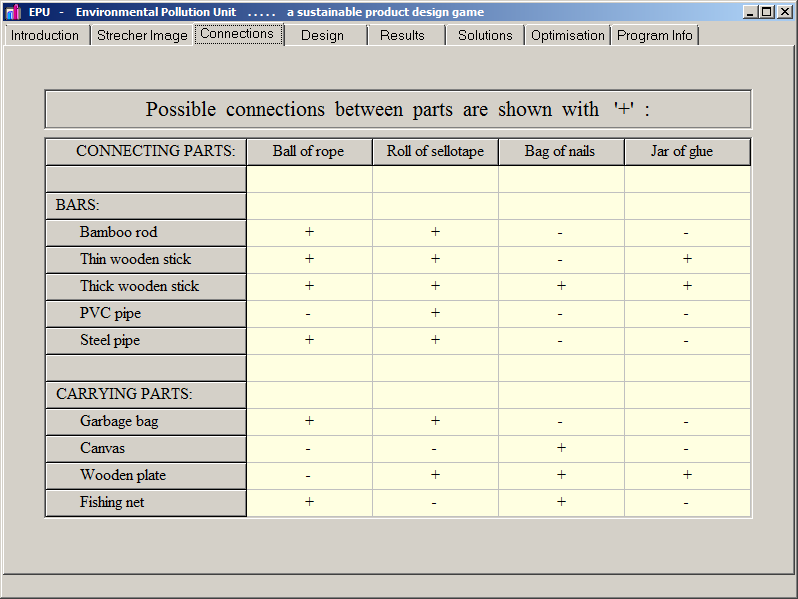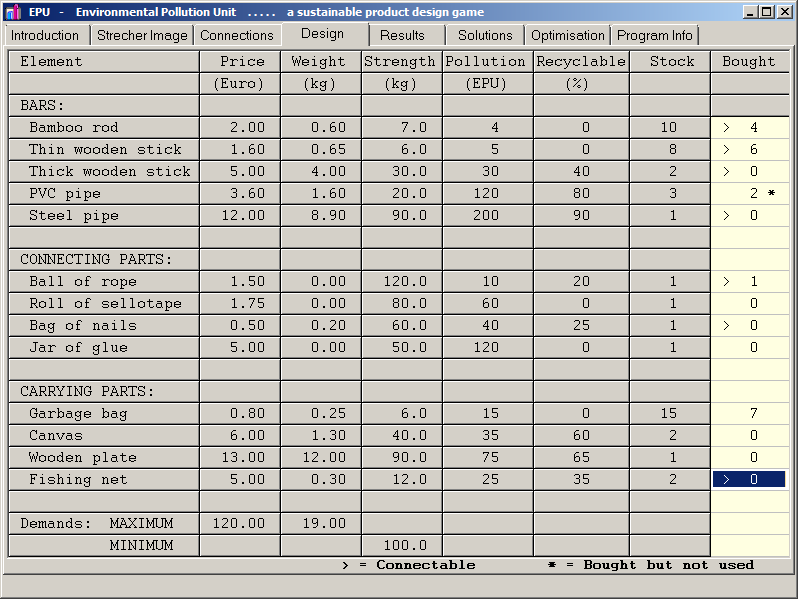EPU: Environmental Pollution Unit A Serious Game: Life Cycle Assessment You can freely download the EPU program. Before you do, first read the copyright statement. |
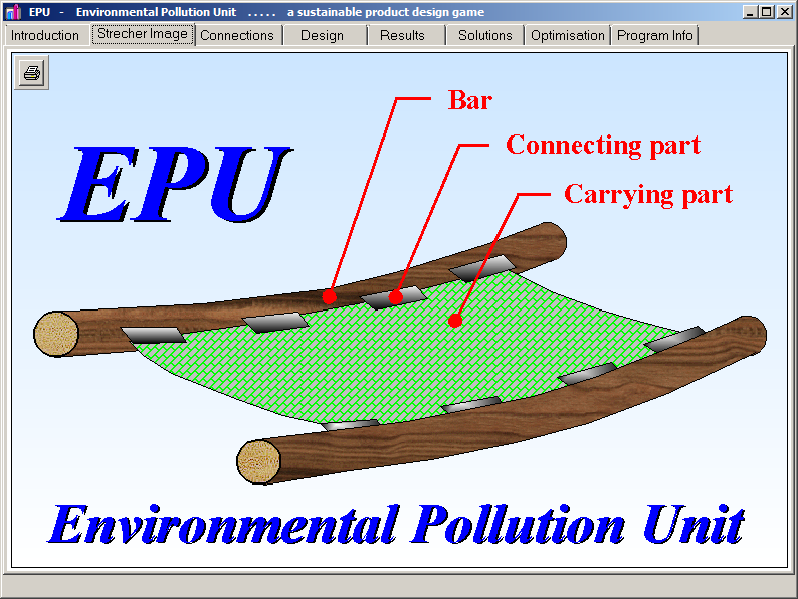
EPU is a serious game to practice the weighing of unweighable factors, as an exercise to get familiar with the kind of dilemmas that are frequently faced in relation to sustainable development.
The goal of the game is to design a stretcher.
The stretcher is to be designed as a sustainable product.
Exercises for students, linked to Roorda's books Fundamentals of Sustainable Development and Basisboek Duurzame Ontwikkeling, make use of the computer program shown on this page.
Lots of materials are available: wooden sticks, bamboo rods, sellotape, nails, garbage bags, fishing nets, etc. Between these materials you have to choose, in order to make a good stretcher which has to meet certain demands.
For instance; the stretcher has to be strong and light. Besides, it has to be cheap, because the materials are not for free: they have to be bought by the player. For this purpose a budget is available: a number of Euros.
The demands are:
1. Cost price: max. 120 euro
2. Weight: max. 19 kg
3. Carrying strength: min. 100 kg
But that is not all. Each of the materials brings with it a certain amount of damage to the environment, due to pollution and of exhaustion of raw materials. This damage has as its unity the so-called "Environment Pollution Unit", EPU.
(The EPU is a fictious unit, only used in this game.)
Your task is, to design the stretcher in such a way that the first three demands are met 100% , while at the same time a fourth demand is met as good as possible:
4. Environmental damage: as low as possible
So, the goal of the game is:
Design a stretcher which meets demands 1 to 3, and which has an EPU score as low as possible.
But still, that is not all. Most of the materials can be used more than once: they can be recycled.
Some materials are more suited for this than others: the amount of recyclability is expressed as a percentage. For instance, if the percentage is 80%, this means that 80% of the used material can be regained when the stretcher is disassembled, and then reused.
Consequence of a high recyclability is that the damage to the environment is lower: an element with an EPU-score of 120 and a recycling percentage of 80% raises the total EPU score of the stretcher with only 20% of 120 EPU, i.e. 24 EPU.
However, there is a disadvantage to this! Regaining the used materials takes time, and time means labour costs. By the way, this is not only true for the disassembly time of the stretcher, but also for the construction time. The total cost price of the stretcher therefore consists of three parts:
Cost price = costs of materials
+ labour costs (construction)
+ labour costs (disassembly)
Labour costs are 0.70 euro per minute.
Construction time is 3 minutes per part; the same amount of time is needed for the disassembly of a recyclable part at the end of the life time.
Therefore, using as few parts as possible is good, both financially and environmentally.
But, although recycling as many parts as possible may be good for the environment, it increases the cost price, due to the extra labour costs. Here, the money and the environment are in conflict with each other.
There are three kinds of parts:
- Bars: for example wooden sticks, PVC pipes, bamboo rods;
- Carriers: for example garbage bags, canvasses, fishing nets;
- Connectors: for example sellotape, rope, nails.
The stretcher has to be made of bars and carriers; and these have to be attached to each other with connectors. Not all connecting parts are suitable for each carrier or bar: for instance, you cannot use nails with garbage bags, because they would tear apart. The image on the right, the Connections Screen, shows which connections are possible (+) or not (-).
Each of the parts has its own strength. For example, PVC pipes are much stronger than bamboo rods.
The strength of the bars, of the carriers and of the connections are calculated separately. The carrying strength of the stretcher is equal to the strength of the weakest section: so, if for example:
- total strength of bars = 140 kg
- total strength of carriers = 55 kg
- total strength of connections = 130 kg
then the carrying strength of the stretcher is only 55 kg: just like a chain, which can never be stronger than its weakest link.
In the EPU game, the designing process is limited to the selection of the materials. The exact way they are to be composed is not of interest in the game.
Selection of the materials is done in the Design Screen, shown left. Here, the cursor can be moved with the up and down arrow keys or with the mouse. For each item, the desired number can be typed in. Of course it is impossible to buy more than there is in stock.
In the Design Screen shows which connections are possible: each time the cursor points at a certain part, the parts that can be attached to it are marked with ‘>’.
When parts are selected which cannot be connected in such a way that they contribute to the strength of the stretcher, they don't count for the strength, the weight and the construction time. They do attribute, however, to the cost price and the environmental damage.
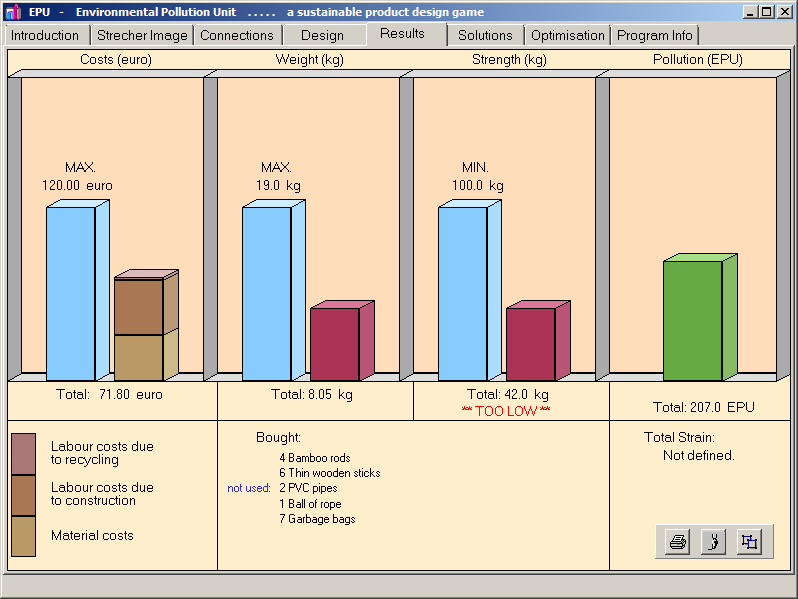 The results are shown in the Results Screen.
The results are shown in the Results Screen.
If the results are not good enough, the player can re-enter the Design Screen and change the selection. This can be repeated an unlimited number of times; the challenge is, not only to find a solution that fits all requirements, but even to find several or even many such solutions, and then select the best of them.
A suggestion:
Try to find (within the given demands):
- the strongest stretcher;
- the cheapest stretcher;
- the lightest stretcher;
- the least polluting stretcher;
- and: the BEST stretcher.
If several people play the game:
Can you agree upon an exact method to determine, which stretcher is the BEST?
Could this method be some kind of a compromise between the four different characteristics of the stretcher?
Finding the best solution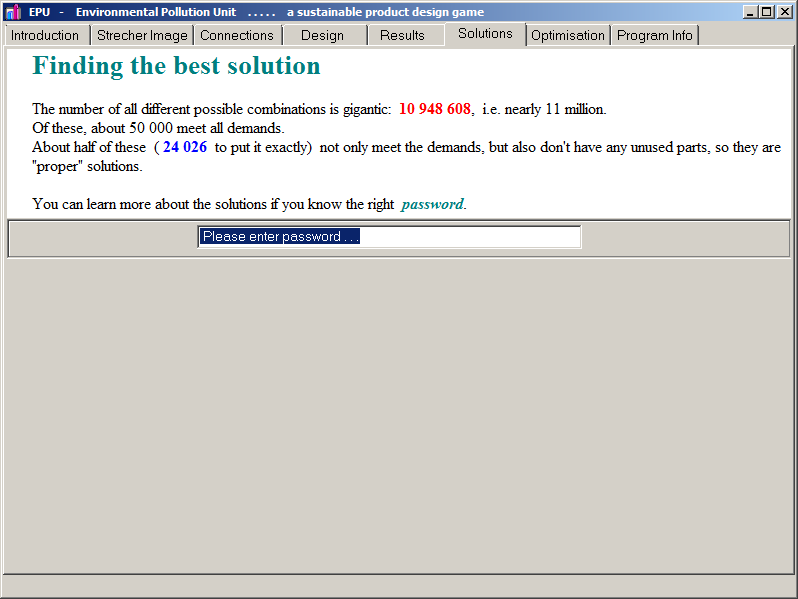
The number of all different possible combinations of materials that you can buy is huge: 10,948,608, i.e. nearly 11 million.
When someone plays the game, at first it will be hard to find just one solution, i.e. one design that meets all demands. After a while however, most players appear to find several solutions.
Actually, there are many solutions! Roughly 50,000.
About half of these (24,026 to put it exactly) not only meet the demands, but also don’t have any unused parts. They can be described as proper solutions.
The EPU program is able to find these solutions all by itself. However, is one would like to start this automatic process, one will need a password that is to be inserted in the Solutions Screen. After that, the program will create a text file and write all solutions in it.
This is done for education purposes: if lecturers in schools or universities want to be able to present all solutions to their students, they may contact Niko Roorda to ask for the password. He / she will have to convince Niko of really being an educator...
How can you find the BEST solution? Of course, this depends on what you choose as your priorities. Perhaps one might think that the polluting effect (the EPU value) is more important by far than all other aspects, and so the design with the lowest EPU value is the best.
Others might argue that for instance the price is very important, or the carrying strength.
Probably, the BEST stretcher is some kind of a compromise.
In order to avoid endless discussions, it would be good if there was some exact method to use as a decision tool.
One way of agreeing on such an exact method is by giving weight factors to each of the four aspects.
Perhaps, you decide on the following weight factors:
Aspect Weight
Price: a = 40%
Weight: b = 10%
Strength: c = 10%
Pollution: d = 40%
Alternatively, you could give all four aspects equally important (i.e. 25% for all of them), or set one or more of the weights equal to zero.
In order to make it possible to compare the four different quantities, i.e. to add or subtract them, they will have to be made dimensionless first. This can be done by dividing each by a characteristic value, a so called reference value. For the price, for instance, this value could easily be the maximum price, that is, the budget. Analogously, the maximum weight and the minimum strength can be used as references.
For the polluting effect, there is no natural value to divide by. So, a reference value has to be chosen. In real life, this value could perhaps be based on values that are characteristic for the average comparable product. Since this is not possible in this computer simulation, an arbitrary number may be chosen.
(Of course, all four reference values will always be arbitrary in some sense.)
Following this idea, a formula can be made. The outcome can be considered as something like the “Total Strain”: that is, the strain on the budget, together with the strain on the muscles of those who will carry the stretcher, plus the polluting strain on the environment. From these, the “advantage” of the carrying capacity may be subtracted, because: the higher this value, the more effective the stretcher is.
The Strain formula can thus be formulated (mark the minus sign in front of c ) :
Price Weight Strength Pollution
Strain = a x ---------- + b x --------------- - c x ---------------- + d x -----------------
Budget MaxWeight MinStrength ReferencePoll
Where:
a , b , c , d >= 0 and a + b + c + d > 0
 In the Optimisation Screen, values can be given to the four weight factors. When you do this and then press the "Done" button, the EPU program will not only calculate the usual characteristics of the designed stretcher but also the Total Strain, thus enabling the user to search for the optimal stretcher.
In the Optimisation Screen, values can be given to the four weight factors. When you do this and then press the "Done" button, the EPU program will not only calculate the usual characteristics of the designed stretcher but also the Total Strain, thus enabling the user to search for the optimal stretcher.
The result is to be found in the Result screen, and is expressed in milli Strain Points (mSP) , i.e. the value shown is multiplied by 1000.
Pressing the "Clear all" button will remove all four values, and the Total Strain will not be calculated any more. Also, if you change one or more of the four values without pressing "Done", the Total Strain will not be calculated.
Internally, the program normalizes all four weight values by dividing them by the sum of them. For instance:
a : = a / ( a + b + c + d ) , etc.
Because of this, the results will have about the same magnitude, even if the sum of the weight factors differs from case to case.
Nevertheless: if different weight factors are used for various cases, the results cannot be compared!
For the pollution reference value ReferencePoll , the program uses the value 1000.
Of course, there are several arbitrary things in the Strain formula. But nevertheless, there is a resemblance with things in real life.
The calculation of an Eco-indicator following a Life Cycle Assessment (LCA) carries the same kind of relative arbitrariness: there too, different kinds of figures are combined.
The principle is exactly the same: in the calculation of an Eco-indicator too, reference values and weight factors are used to enable addition. Decisions about the values of these numbers are usually based on a combination of scientific, technical, cultural, ethical, commercial and political considerations.


